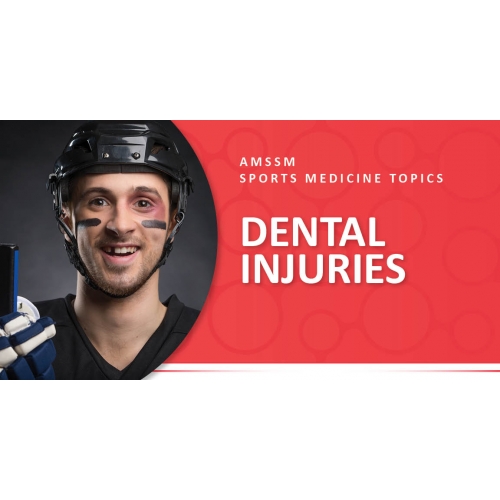 Background Sports-related dental injuries account for 40% of all dental injuries in the United States, Single-season incidence is commonly cited at 10% with males more likely to sustain injuries, and there are often more injuries in sports that are fast paced and have high-speed impacts. Symptoms/Risks Symptoms vary depending on the location of the injury. Fractured bones and teeth have obvious visual deformities and often have sensitivity and pain. Athletes can also experience bleeding, swelling, bruising, and redness of dental tissues and structure. Risks associated with dental injuries include several outside and internal factors. • Outside factors: equipment status, coaching and refereeing behaviors, quality of the playing surface, weather conditions, etc. • Internal factors: age, gender, body size, medical history, previous injuries, periodontal status, etc. Sports Medicine Evaluation & Treatment When evaluating and treating dental injuries, a sports medicine physician considers the immediate impact, as well as future aesthetics, functionality and cost. Quick assessment and early treatment is the primary goal. • Soft Tissue Injuries: Most common dental injures seen in athletes are usually caused by direct trauma. A physician will evaluate of the anatomical structures (the mandible,gums, teeth, tongue and cheeks) and check the motion of the jaw. They will visually inspect these regions and check for conditions like edema, erythema, lacerations or punctures. They may also consider x-ray imaging. • Tooth dislocations (avulsions): A doctor could consider reinserting a tooth within 10-30 minutes for adult/permanent teeth. If this isn’t possible, the tooth should be placed in an appropriate solution (including a medical isotonic solution, milk, sterile saline or saliva) and transported to a dentist for reimplantation and splinting. • Displaced tooth within socket (luxations): If this happens, a physician will use gloves and manually move the tooth to normal its normal position and then transport the athlete to a dentist. • Tooth fractures: If the fracture reaches the soft part of the tooth, the athlete may experience pain and sensitivity. Temporary calcium hydroxide treatment can be used until dental evaluation can occur, usually with 24 hours. • Jaw dislocation: Athletes might have inability to move the jaw, have felt a popping sensation in the jaw or have visual deformity which suggests dislocation. Lateral movement of the jaw by the athlete may reduce dislocations, and if a physician is unable to achieve reduction, urgent dental consultation is required. Injury Prevention Preseason oral health screenings can help treat underlying periodontal diseases and identify those with an increased risk for dental injuries. Mouthguards offer the most significant advancement in oral protection. The NCAA began requiring use of mouth guards in 1962 for football, and they helped reduce trauma to the teeth and jaw. The American Dental Association and the International Academy of Sports Dentistry recommend the use of mouth guards in 30 athletic events. Three types of mouth guards are commercially available • Stock mouth guards • “Boil-and-bite” mouth guards • Custom-fitted mouth guards Emergency action plan: Ensure either a sports dentist is sideline or locally available. When preparing equipment, have toothsaving kits available. Return to Play Return to play should be individualized based on sport, position and likelihood of recurring injury. Standard recommendations are collected from the National Athletic Trainers’ Association and the International Association of Dental Traumatology. • Avulsion without replantation: 48 hours • Avulsion with replantation: 2-4 weeks with mouth guard and face mask use • Luxations: 24-48 hours after correction with mouth guard • Tooth Fractures: Return to play varies based on depth and treatment, consult dentist • Jaw dislocation: 2-4 weeks, increased risk of repeat dislocation AMSSM Member Authors References Category: Head, [Back] |

